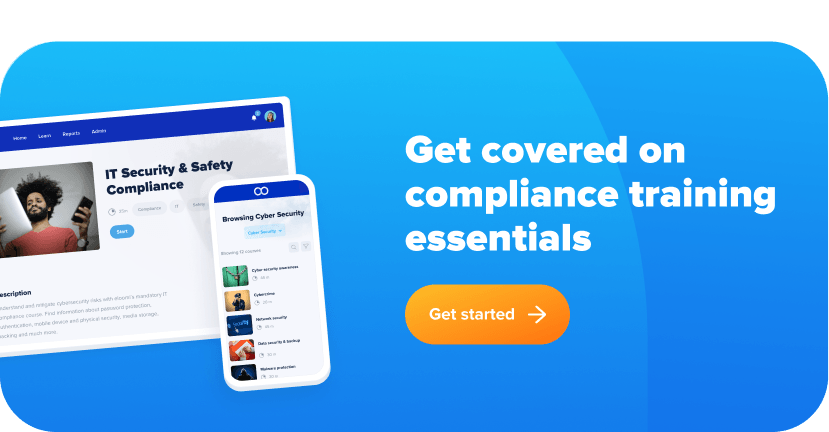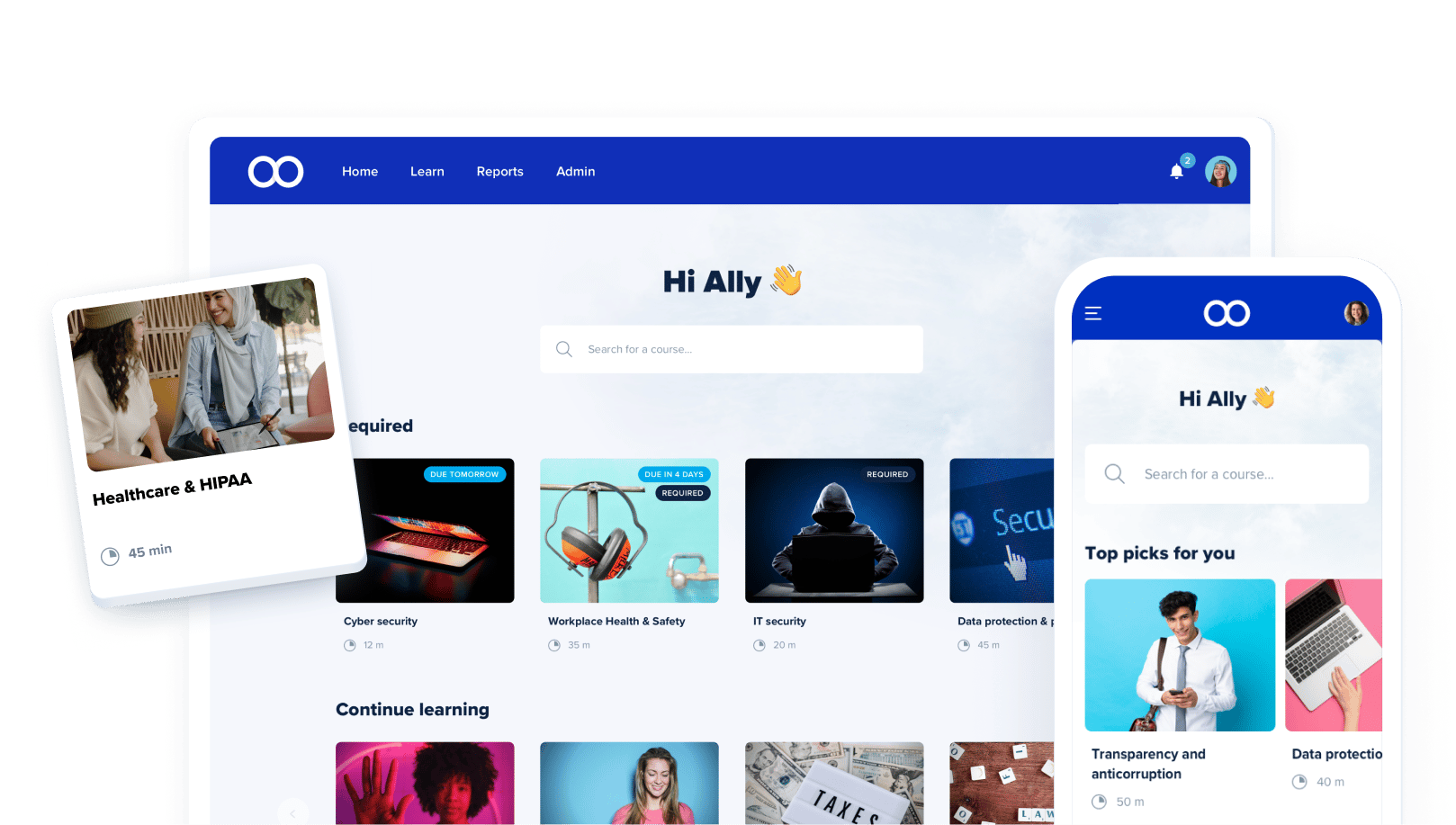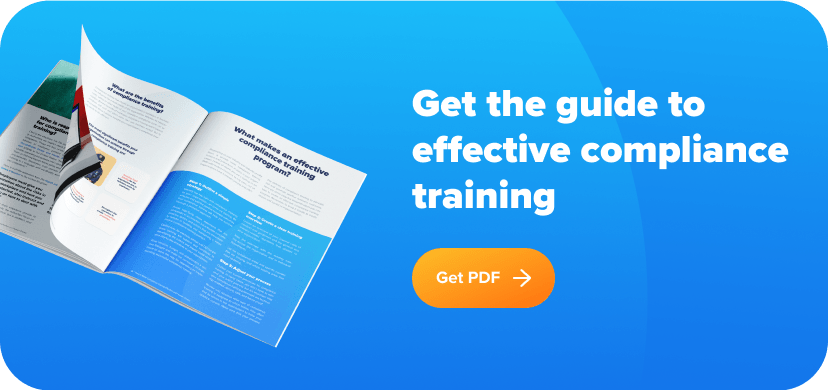What it is: Anti-harassment and anti-discrimination training gives employees an understanding of what is and what is not acceptable workplace behavior.
Why it matters: This training seeks to prevent harassment and discrimination at all levels in your workplace by creating a comfortable and inclusive work environment.
Compliance Recommendation: This article is focused on anti-harassment and anti-discrimination training for all your employees. You should also provide separate training for managers that teaches them how to handle harassment and discrimination allegations and potentially inappropriate discussions.

Anti-Harassment Training
In states where sexual harassment training isn’t required, this training can take its place while including additional topics. If you are required to provide sexual harassment training, it’s good to keep that separate and documented.
Defining Workplace Harassment
According to the Equal Employment Opportunity Commission (EEOC), workplace harassment is any unwelcome conduct based on an employee’s race, color, religion, sex (including sexual orientation, gender identity, or pregnancy), national origin, age (if 40 or older), disability, or genetic information.
This type of harassment becomes illegal when enduring the harassment becomes a condition of continued employment or the harassment creates a hostile, abusive, or intimidating work environment.
Your compliance training also needs to emphasize what is unacceptable behavior versus what is illegal behavior. Sometimes a comment can be rude or inconsiderate, but that doesn’t make it illegal. Giving examples can help you clarify to your employees that neither type of behavior is acceptable, but only one is illegal.
Avoid Retaliation
Workplace harassment often occurs when a manager or supervisor harasses an employee who reports to them. This is illegal.
If that manager, their manager, HR, or any other company representative takes adverse employment action against the employee complaining of harassment, that’s also illegal. This doesn’t always come in the form of termination, either. It may also include a demotion, reduction in pay, fewer hours scheduled, or any other act that could be a negative employment action.
Employer Liability
If you have a manager or supervisor who harasses another employee and the harassed employee receives a negative employment action, your company is automatically liable.
According to the EEOC, your company can only avoid liability if you can prove both of the following:
- Your company reasonably tried to prevent and correct the harassing behavior
- The employee being harassed unreasonably failed to take advantage of any preventive or corrective opportunities provided by your company
If you have a non-supervisory employee harassing another employee, your company will be liable if you knew or should have known about the harassment and failed to take prompt action. This is why it’s crucial for your company to have an anti-harassment policy that your HR and people team follows every time

Anti-Discrimination Training
Anti-discrimination training is similar to anti-harassment training. Many of the same protected classes described above apply here. Because of the similarities, these trainings are often included together.
Defining Discrimination
Workplace discrimination occurs when a person or group of people are treated unfairly or unequally because of some common reason or characteristic. According to the EEOC, workplace discrimination because of your race, color, religion, sex (including pregnancy, gender identity, and sexual orientation), national origin, disability, age (if 40 or older), or genetic information.
Types of Discrimination
Anti-discrimination training is intended to prevent several types of discrimination in the workplace. This includes:
- Unfair treatment based on a protected status
- Harassment by colleagues, managers, or others in the workplace
- Denial of a reasonable workplace accommodation needed because of a religious belief or disability
- Retaliation because of a complaint about workplace discrimination
- Improper questions about genetic information or medical information
Examples of Workplace Discrimination
Discrimination can occur at any stage of the employment process. This includes the application stage. In fact, the EEOC recently released a statement putting businesses on notice that their resume screening software may violate anti-discrimination laws because it may unfairly reject candidates with disabilities.
One of the most frequent violations of anti-discrimination laws in the workplace center on race and sex. When a company refuses to hire someone, promote an employee, or take any other action because of the employee’s race or sex, that is illegal. When an employer gives workers in one racial group less of an annual increase than workers in another racial group, that’s illegal.
Another area where employers often get into trouble, sometimes unknowingly, is with applicants and employees with disabilities. Employers must provide reasonable accommodations to applicants and employees who request them. For example, if you have an applicant who’s in a wheelchair and they request you conduct the interview on the main floor because your office is on the second floor of a building without stairs, that’s a reasonable accommodation and you must comply.

During the interview process, you cannot ask applicants about their disability. You cannot ask whether they have any medical condition that might affect their ability to do the work you need done. You must keep the conversation focused on the skills necessary to do the job. If a disabled applicant brings up their disability, don’t ask follow-up questions and do not use their disability as a reason to reject them from employment.
Retaliation is another common and illegal practice of workplace harassment and discrimination. When an employee makes a complaint, you cannot take any adverse employment action against them because they filed a complaint.
Yet, not every action by a company rises to the level of discrimination. If an employee receives a poor work performance review and is demoted, does not receive a raise, or is terminated as a result, that doesn’t always mean an employer discriminated against them. To effectively overcome an allegation of discrimination, you’ll need to prove that your adverse employment decision was based solely on work-related factors, like poor work performance. And providing your employees with anti-discrimination training can bolster your case that you take these issues seriously and do what you can to prevent them.
Practical Note: Be aware that you cannot prevent any employee from suing you. Your company can and should develop policies and practices that can be used to give your company an affirmative defense, including employee training. Having these operational pieces in place may make it more likely that any legal action against your company would be unsuccessful.

Preventing Workplace Harassment & Discrimination is Good Business
Preventing workplace harassment and discrimination is just the right thing to do. You want your employees to have a healthy, happy, and enjoyable work experience. If they feel like they’re in a toxic environment, one where they can’t be honest, or one where they feel harassed or bullied, they’re going to leave at the first opportunity. But they’re also going to be less productive and engaged.
While you cannot prevent every act of poor workplace behavior, you can take proactive steps to provide the safest, most inclusive, and non-toxic work environment. You do that by offering your employees anti-harassment and anti-discrimination training. Do this within one month of hiring any new employee and give an updated training to your entire company at least once per year. You should also have a separate training that’s required for supervisors and managers.
For each of these trainings, you should also make sure you note every employee present, whether virtually or in person. Also make sure to get a signed acknowledgement form from each employee stating that they have received the training and that they agree to abide by the lessons taught.
Harassing and discriminating behavior creates a work environment no one wants to be a part of and one that will make company profits fall. Because of a lack of engagement and desire, employees will be less productive, resulting in falling revenue. Having a clear, concise, and current training plan will help you provide your team with the right information, and give you a shield for any potential compliance issues.

Ensuring best-in-class compliance training with eloomi
It’s important that you take proactive steps to ensure your employees are properly trained on required and recommended training necessary for them to do their jobs. To help you, partner with a training platform does the hard work for you, so you can focus on your core business needs. With eloomi, we make sure your digital compliance training is up to date and contains accurate information to help guide and support your employees in their work.
Get in touch to learn more about our compliance training solutions and curated content bundles.





